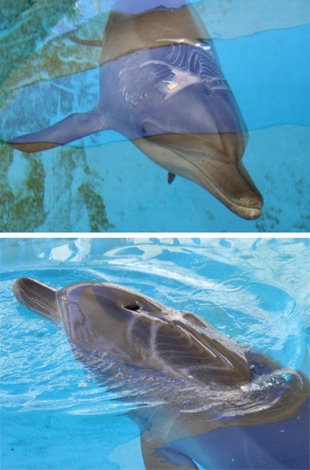In February 2009, a bottlenose dolphin named Nari swam up to the Tangalooma Wild Dolphin Resort on Moreton Island off Australia’s Queensland. Dozens of wild dolphins, including Nari, routinely entered an adjacent bay every night for dinner—hand fed fish by tourists and resort staff. But on this night, the workers immediately noticed something was wrong: Nari was missing a huge chunk of blubber from his dorsal surface, just behind his blowhole.
As Trevor Hassard, director of the Tangalooma Marine Education and Conservation Centre, came rushing down to the wharf, he knew immediately that Nari’s injuries were the work of a shark—and this was one of the worst bites he had seen in his 19 years at the facility. “It was absolutely horrific,” he recalls. Worried that the bite may have nicked Nari’s trachea, Hassard sent some pictures of the injured dolphin to David Blyde at the nearby Sea World...
Sea World veterinarians arrived the following day, but Nari didn’t return to Tangalooma for the next two nights. When he entered the bay on the third night, the biologists could already see significant signs of healing, including the discoloration of the dying, or nonviable, skin, blubber, and muscle. “Already all of the nonviable tissue had turned white and strings of nonviable tissue were radiating from the wound,” Hassard says. Still unsure whether the trachea had been pierced, however, they decided to capture Nari and take him to Sea World, where he was given surgery to remove dead tissue, as well as antibiotics and a quiet environment for recovery. Within a month, Nari’s wounds had fully healed, and he was soon released back into the wild.

“Dolphins just have this amazing healing ability,” Hassard says. And they heal “without infection and without swelling,” and seemingly without pain, he added. “They sustain these lacerations or injuries in their skin, through their blubber down to the muscle, and it doesn’t seem to bother them,” agrees Brent Whitaker, deputy executive director for biological programs at the National Aquarium in Baltimore.
But despite the widespread recognition of the animals’ impressive restorative powers, little is known about the biological basis of the phenomenon. When Michael Zasloff of Georgetown University Hospital first learned of dolphins’ healing ability, he was “plagued” by the question of how they do it, he says. “It is beyond my wildest imagination.” For 10 years, he investigated the matter, and in a letter published in the Journal of Investigative Dermatology in July (10.1038/jid.2011.220), he posited several hypotheses about how these animals might be able to heal the way they do.
The first aspect of dolphin healing he addressed was the marine mammals’ remarkable resistance to infection. Zasloff had previously discovered the existence of antimicrobial peptides in the skin of frogs and dogfish sharks, and he suspected dolphins might possess similar compounds. Candidates include organohalogens, a class of compounds with antimicrobial properties that are made by many marine organisms, such as algae and plankton, Zasloff says. “The dolphin, because of its position on the food chain, ultimately will ingest these compounds,” which could then be stored in the animals’ fatty blubber and released by tissue breakdown at the site of injury. Another possible antimicrobial compound, he adds, is isovaleric acid, which is likely produced by the dolphins themselves, and is found in high levels in the blubber of some cetaceans.
Zasloff also wondered whether dolphins might harbor some sort of painkilling substance that allows them to maintain their normal behaviors in the face of serious injury. “The soft tissue [around the injury] or the regenerating new tissue must be liberating something,” Zasloff says, “and that something, I think, [could be] a morphine-like substance.” Alternatively, dolphins may just be “wired” to live with pain, Whitaker says. “Dolphins are very stoic. They don’t show when they feel bad.”
In addition to staving off infection and pain, dolphins are able to restore damaged tissues without significant deformation or scarring. This appears to be a result of the animals’ ability to regenerate the matrix of fat and elastic fibers woven through their blubber, Zasloff says. “Within a day or so, the nonviable tissue turns a whitish color and sloughs off,” Hassard explains. “[Then], bright red tissue starts to form at the base of the wound and slowly grows and fills the wound completely.”
Understanding these abilities could one day inform human medicine, Zasloff hopes. “If the dolphin has basically screened the diversity of antimicrobial agents from the ocean and selected those which are compatible with its physiology and with the microbes that it ultimately has to tangle with, those compounds might be compatible with our physiology,” he says. “These might be the types of compounds we are looking for to deal with serious gram-negative infections.”
“If we can learn how they do it,” Whitaker agrees, “we might be able to take something away that we can apply to human or other animal health.”
See the full slideshow.[gallery]
Interested in reading more?





